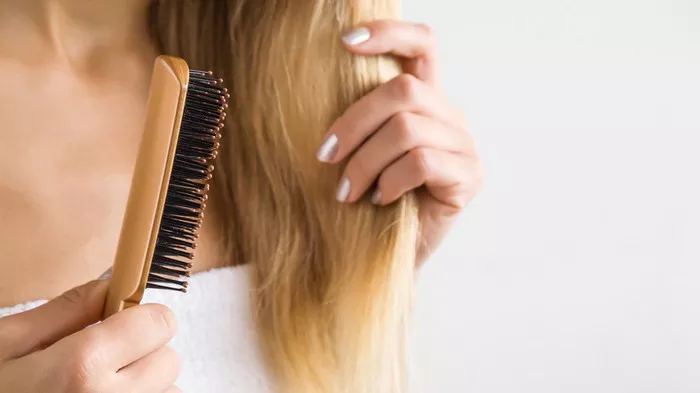Hair loss is a common concern for many individuals, and it is natural to wonder how much hair loss is normal during the daily grooming routine. In this informative article, we will explore the topic of hair loss when combing and provide insights into the shedding process. Understanding the normal amount of hair loss can help alleviate concerns and provide a foundation for maintaining healthy hair. Join us as we delve into the intricacies of hair shedding, shedding light on what is considered normal and when to seek professional advice.
The Hair Growth Cycle:
To understand hair loss, it is essential to comprehend the natural hair growth cycle. Hair follicles undergo a continuous cycle of growth, rest, and shedding. The growth phase, known as anagen, can last several years, followed by a brief transition phase called catagen. Finally, the resting phase, known as telogen, occurs for a few months before shedding and the cycle starts anew.
Daily Hair Shedding:
It is normal to experience daily hair shedding as part of the natural hair growth cycle. On average, individuals lose approximately 50 to 100 hairs per day. This shedding is a result of older hairs reaching the end of their growth phase and making way for new hair growth. Therefore, finding a few strands of hair on the comb during daily grooming is generally considered within the normal range.
Factors Influencing Hair Shedding:
Hair shedding is influenced by various factors, including:
Genetics:
The genetic makeup plays a significant role in determining the thickness, density, and overall health of hair. Some individuals may be genetically predisposed to have a higher or lower rate of hair shedding.
Age:
Hair shedding tends to increase with age. As we get older, the hair growth cycle may slow down, leading to more hair entering the resting phase and eventually shedding.
Hormonal Changes:
Hormonal fluctuations can affect the hair growth cycle and lead to temporary hair shedding. For example, hormonal changes during pregnancy, postpartum, and menopause can cause shifts in hair growth patterns.
Medical Conditions and Treatments:
Certain medical conditions, such as thyroid disorders, autoimmune diseases, and scalp infections, can contribute to excessive hair shedding. Additionally, undergoing treatments like chemotherapy or radiation therapy can cause significant hair loss.
Nutritional Deficiencies:
Inadequate nutrition, particularly deficiencies in essential vitamins and minerals, can impact hair health and lead to increased shedding. Nutrients like iron, biotin, zinc, and vitamin D are vital for healthy hair growth.
Physical and Emotional Stress:
Physical stressors, such as undergoing surgery, experiencing a severe illness, or sudden weight loss, can trigger temporary hair shedding. Emotional stress, such as extreme anxiety or emotional trauma, can also disrupt the hair growth cycle.
If you have concerns about excessive hair shedding or notice significant changes in your hair density, it’s advisable to consult a healthcare professional or dermatologist for a proper evaluation and guidance.
Maintaining Healthy Hair:
Maintaining healthy hair involves a combination of good hair care practices and a healthy lifestyle. Here are some tips to help you keep your hair healthy:
Regular Washing:
Wash your hair regularly to keep it clean and free from dirt, excess oil, and product buildup. However, avoid overwashing, as it can strip your hair of its natural oils, leading to dryness.
Proper Conditioning:
Use a suitable conditioner after shampooing to moisturize and nourish your hair. Focus on the ends of your hair, as they tend to be drier and more prone to damage.
Be Gentle:
Handle your hair gently to prevent breakage and damage. Avoid aggressive brushing or combing, especially when your hair is wet, as it is more vulnerable at that time. Use a wide-toothed comb or a brush with soft bristles to detangle your hair.
Protect from the Sun:
Shield your hair from prolonged sun exposure by wearing a hat or using hair products that contain SPF. The sun’s rays can dry out and damage your hair, leading to frizz and brittleness.
Balanced Diet:
Maintain a balanced diet rich in vitamins, minerals, and proteins to promote healthy hair growth. Include foods like fruits, vegetables, lean meats, fish, nuts, and whole grains. Drinking an adequate amount of water also helps keep your hair hydrated.
Regular Trimming:
Schedule regular trims every 6-8 weeks to remove split ends and prevent them from traveling up the hair shaft. This helps maintain the overall health and appearance of your hair.
By adopting these practices, you can promote the health and vitality of your hair, ensuring it looks and feels its best.
Conclusion:
Understanding the normal amount of hair loss when combing is essential for maintaining peace of mind and recognizing potential hair health concerns. While finding a few strands of hair on the comb is generally within the normal range, it is crucial to be aware of any excessive hair loss or changes in hair density. By maintaining a healthy lifestyle, adopting proper hair care practices, and seeking professional advice when necessary, you can promote hair health and ensure that your tresses remain vibrant and resilient.


